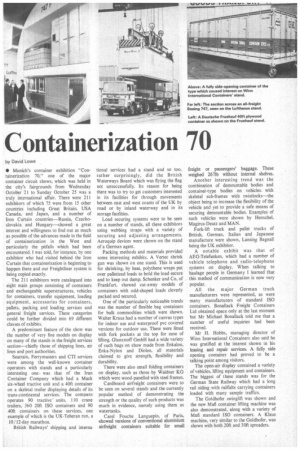Containerization 70
Page 19

If you've noticed an error in this article please click here to report it so we can fix it.
by David Lowe • Munich's container exhibition "Con tainerization 70," one of the major container circuit shows, which was held in the city's fairgrounds from Wednesday October 21 to Sunday October 25 was a truly international affair. There were 211 exhibitors of which 75 were from 15 other countries including Great Britain. USA Canada, and Japan, and a number of Iron Curtain countries—Russia, Czechoslovakia and Hungary—showed a great interest and willingness to find out as much as possible of the advances made in the field of containerization in the West and particularly the pitfalls which had been encountered. I was told, for instance, by one exhibitor who had visited behind the Iron Curtain that containerization is beginning to happen there and our Freightliner system is being copied exactly.
The 211 exhibitors were catalogued into eight main groups consisting of containers and exchangeable superstructures, vehicles for containers, transfer equipment, loading equipment, accessories for containers, pallets. packing and loading services and general freight services. These categories could be further divided into 69 different classes of exhibits.
A predominant feature of the show was the number of very fine models on display on many of the stands in the freight services section—chiefly those of shipping lines, air lines and port authorities.
Seatrain, Ferry masters and CTI services were among the well-known container operators with stands and a particularly interesting one. was that of the Iran Container Company which had a Mack six-wheel tractive unit and a 40ft container on a skeletal trailer displaying details of its trans-continental services. The company operates 90 tractive' units. 110 crane trailers, 360 20ft ISO containers and 90 40ft containers on these services, one example of which is the UK-Teheran run, a 10/12-day marathon.
British Railways' shipping and interna
tional services had a stand and so too, rather surprisingly, did the British Waterways Board which was flying the flag not unsuccessfully. Its reason for being there was to try to get customers interested in its facilities for through movements between east and west coasts of the UK by road or by inland waterway and in its storage facilities.
Load securing systems were to be seen on a number of stands, all these exhibitors using webbing straps with a variety of securing and adjusting arrangements. Aeroquip devices were shown on the stand of a German agent.
Packing methods and materials provided some interesting exhibits. A Vertec shrink gun was shown on one stand. This is used for shrinking, by heat, polythene wraps put over palletized loads to hold the load secure and to keep out damp. Schenker and Co, of Frankfurt, showed cut-away models of containers with odd-shaped loads cleverly packed and secured.
One of the particularly noticeable trends was the number of flexible bag containers for bulk commodities which were shown. Walter Kraus had a number of canvas types for indoor use and waterproof pvc covered versions for outdoor use. These were fitted with fork pockets at the top for ease of lifting. Glanzstoff GmbH had a wide variety of such bags on show made from Enkalon, Enka-Nylon and Diolen, all materials claimed to give strength, flexibility and durability.
• There were also small folding containers on display. such as those by Weidner KG which were wood-panelled with steel frames.
Cardboard airfreight containers were to be seen on several stands and the currently popular method of demonstrating the strength or the quality of such products was much in evidence, namely using them as watertanks.
Care! Fouche Languepin. of Paris, showed versions of conventional aluminium ahfreight containers suitable for small freight or passengers' baggage. These weighed 2671b without internal shelves. Another interesting trend was the combination of demountable bodies and container-type bodies on vehicles, with skeletal sub-frames with twistlocks—the object being to increase the flexibility of the vehicle and yet to provide a safe means of securing demountable bodies. Examples of such vehicles were shown by Henschel. Magirus-Deutz and MAN.
Fork-lift truck and pallet trucks of British, German, Italian and Japanese manufacture were shown, Lansing Bagnall being the UK exhibitor.
A notable exhibit was that of AEG-Telefunken, which had a number of vehicle telephone and radio-telephone systems on display. When talking to haulage people in Germany I learned that this method of communication is now very popular.
All the major German truck manufacturers were represented, as were many manufacturers of standard ISO containers. Bonallack Freight Containers Ltd obtained space only at the last moment but Mr Michael Bonallack told me that a number of useful inquiries had been received.
Mr H. Hobbs, managing director of Winn International Containers also said he was gratified at the interest shown in his leasing and repair services. A fully side opening container had proved to be a talking point among visitors.
The open-air display contained a variety of vehicles, lifting equipment and containers.
The biggest of these stands was for the German State Railway which had a long rail siding with railfalts carrying containers loaded with many sample traffics.
The Goldhofer swinglift was shown and the new Mafi container lifting machine was also demonstrated, along with a variety of Mafi standard ISO containers. A Klaus machine, very similar to the Goldhofer, was shown with both 20ft. and 30ft spreaders.








































































































